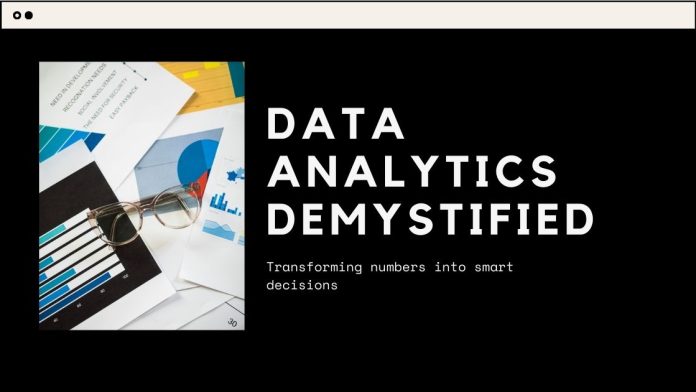Let’s be honest—“data analytics” sounds like something only data scientists and math wizards deal with, right? But here’s a truth bomb: in today’s world, if you’re not using data to drive your decisions, you’re not just missing out—you’re falling behind.
Whether you’re an entrepreneur, a student, a content creator, or someone working a 9-to-5, data analytics has the power to completely change the way you work, think, and grow. And no, you don’t need a computer science degree to get started.
Ready to make smarter decisions with confidence? Let’s break it down.
What Is Data Analytics? (And Why Should You Care?)
Data analytics is the process of collecting, organizing, analyzing, and interpreting data to make informed decisions. Think of it as taking all the raw information around you—sales numbers, customer behavior, social media stats—and turning it into insights that actually mean something.
In simpler terms, it’s how businesses know what products are popular, how marketers figure out what’s working, and how Netflix knows exactly what show to recommend next.
Now here’s the kicker: it’s not just for big companies or tech firms. Anyone can harness data to get ahead—if you know what to look for.
Why Data Analytics Is a Game-Changer
1. Clarity in Decision-Making
Data helps cut through the noise. Instead of relying on gut feeling, you can make decisions backed by real facts and trends.
2. Boosting Productivity
Analyzing how time, money, and resources are used can highlight areas for improvement. Work smarter, not harder.
3. Understanding Customer Behavior
Whether you run a business or manage a blog, analytics can tell you who your audience is, what they like, and how to better serve them.
4. Identifying Opportunities
From market trends to operational inefficiencies, data can shine a spotlight on hidden potential you didn’t know existed.
5. Gaining a Competitive Edge
The businesses and individuals who master data analytics are usually the ones ahead of the curve—faster decisions, better targeting, and stronger results.
Types of Data Analytics
Before diving in, it’s good to understand the four main types of analytics:
🔍 Descriptive Analytics
This tells you what has happened. Think of it as looking in the rearview mirror—sales reports, website traffic, social media engagement.
🔮 Predictive Analytics
This forecasts what could happen using historical data and trends. Tools like machine learning often fall here.
⚙️ Diagnostic Analytics
This helps you understand why something happened. For example, why your sales dropped last quarter.
🎯 Prescriptive Analytics
This goes one step further—it suggests what actions to take. Think of it like a smart assistant giving you advice based on your data.
Real-Life Examples of Data Analytics in Action
Let’s bring this down to earth:
- Marketing: Businesses use Google Analytics to track which ads convert best.
- Retail: Stores analyze shopping habits to recommend products and adjust inventory.
- Healthcare: Hospitals use patient data to improve care and reduce wait times.
- Fitness Apps: Your smartwatch tracks data on sleep, heart rate, and activity to help you improve your health.
- Education: Teachers use student performance data to customize learning plans.
How YOU Can Start Using Data Analytics Today
Even if you’re not a “numbers person,” these simple tips will help you use data to your advantage:
1. Set a Goal
Start with a clear question. For example: “Which blog posts get the most engagement?” or “What time of day are my followers most active?”
2. Pick the Right Tool
Here are a few beginner-friendly platforms:
- Google Analytics – for website data
- Microsoft Excel / Google Sheets – for custom data tracking
- Tableau or Power BI – for visual dashboards
- Social Media Insights – built into platforms like Instagram, LinkedIn, and YouTube
3. Track the Right Metrics
Don’t drown in numbers. Focus on KPIs (Key Performance Indicators) that matter—conversion rate, engagement rate, customer retention, etc.
4. Visualize the Data
Use charts and graphs to make your insights easier to understand. A visual summary is often more powerful than a table full of numbers.
5. Take Action
Analytics are only useful if you act on what you learn. Spot trends, make adjustments, test new ideas—and repeat.
Frequently Asked Questions About Data Analytics
1. Do I need to know coding to get into data analytics?
Nope! Many tools today are no-code or low-code. While knowing Python or SQL can help, it’s not required for basic analytics.
2. What’s the difference between data analytics and data science?
Data analytics focuses on insights and decision-making. Data science digs deeper—building algorithms, models, and often involves machine learning.
3. Is data analytics only for businesses?
Not at all. Freelancers, educators, non-profits, content creators, and students can all benefit from data-driven insights.
4. How long does it take to learn data analytics?
You can pick up the basics in a few weeks. Mastery takes time, but hands-on practice with real data accelerates the process.
5. Can data analytics be automated?
Yes! Many tools can automatically generate reports and dashboards. However, the human touch is still needed to interpret and act on insights.
In today’s digital world, data is everywhere but insight is rare. It’s easy to get lost in numbers or ignore them entirely. But when you learn to read the story your data is telling, you unlock incredible power.
Whether you want to grow your business, improve your productivity, or make smarter content, data analytics is the key to moving with purpose—not just guesswork.
And here’s the best part: You don’t have to be an expert to start. You just have to start.
How are you currently using data in your day-to-day life or work? Do you have any time-saving tricks or favorite tools you’d recommend?
Drop your strategies, tips, or questions in the comments below. Your insights could spark someone else’s breakthrough!
And if this post helped demystify analytics for you, consider sharing it with a friend or team member. Let’s make data-driven thinking part of everyone’s toolkit. 🚀📊

